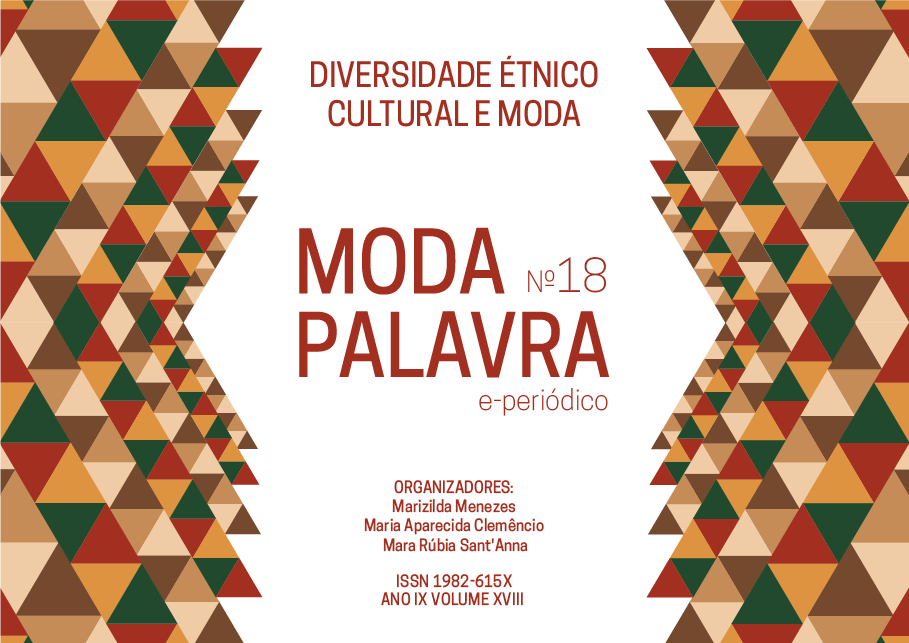Ethnic Signs in the 21stcentury’s fashion: Pre-Columbian Cultural manifestations in creation of atemporal products
DOI:
https://doi.org/10.5965/1982615x09182016043Keywords:
fashion, pre-Columbian culture, ethnic signsAbstract
The culture is manifested through knowledge, beliefs, legends, customs and ways of life of a people, which can be moved and re-interpreted in a fashion product that is hoped to be observed by an interpreter loaded with cultural background. The formal innovation is reactivated in fashion every moment with more aberrant and arbitrary forms, on the aesthetic level, with the sole purpose of providing an ever-new material of different signs. By portraying cultural aspects in fashion whether in clothing or accessories, it’s ephemerality character is reduced, since more timeless objects or products are proposed. This article aims seeks a review of the relevance of cultural events and ethnic groups in the fashion of the century, in addition to making an approach to the creative process of a collection of accessories with references in pre-Columbian cultures of the people Incas, Mayas and Aztecs.
Downloads
References
BALAGUERA, Y.L.S. La influencia de los materiales en el significado de la joya. Cuaderno del Centro de Estudios en Diseño y Comunicación, n. 46, p. 115–153, 2013.
BARTHES, Roland. Elementos de semiologia. 4. ed. São Paulo: Cultrix, 1996.
BAUDRILLARD, J.Função-signo e lógica de classe. in: A Economia Política dos Signos. São Paulo: Editora Martins Fontes, 1996. Pág. 9-49.
BRAGA, J. Historia da moda: uma narrativa. São Paulo: Anhembi Morumbi. 2004.
DETANICO, F.B.; TEIXEIRA, F.G; SILVA, T.K. A Biomimética como Método Criativo para o Projeto de Produto. Design & Tecnologia,n. 2, 2010. Disponível em < http://www.pgdesign.ufrgs.br/designetecnologia/index.php/det/article/viewFile/52/33. Acesso em 15 de abril de 2015.
FARBIARZ, Alexandre; FARBIARZ, Jackeline Lima; NOJIMA, Vera Lucia dos Santos. Os quatro ventos da comunicação.In: COELHO, Luiz Antonio L. (org.). Design método. Rio de Janeiro: Ed. PUC-Rio; Teresópolis: Novas Idéias, 2006. p.64-86.
GARCIA, Carol. Recombinações: Auditions Brasil 2014. Disponível em: < http://www.auditionsbrasil.com.br/tag/recombinacoes/>. Acesso em: 23 de novembro de 2014.
GOLA, E. A Joia: História e design.São Paulo: SENAC/SP, 2008.
GRUBE, N. Maya: Divine Kings of the Rain Forest. Cologne:Könemann Press, 2006.
HENDERSON, J.L. Os mitos e o homem moderno. In:JUNG, C.G. O homem e seus símbolos. Rio de Janeiro: Nova fronteira, 2008, cap. II, p.133-205.
LARAIA, R. B. Cultura: um conceito antropológico. Rio de Janeiro: Jorge Zahar, 2002.
LIPOVETSKY, Gilles. O Império do Efêmero: a moda e seu destino nas sociedades modernas. São Paulo: Companhia da Letras, 2009.
MOLES, Abraham A. Teoria dos Objetos. Rio de Janeiro: Edições Tempo Brasileiro, 1981.
MORAES, A. D. de. Contos e lendas do Peru. WMF Martins fontes, 2002.
OSTROWER, Fayga. Criatividade e processo de criação. Petrópolis: Vozes, 1987.
SUDJIC, Deyan. A Linguagem das Coisas. Tradução por Adalgisa Campos da Silva. Rio de Janeiro: Intrínseca, 2010.
TEIXEIRA, M.B.S. Design de joias em Minas Gerais. A construção de uma identidade. In: CASTAÑEDA, Cristiane; ADDAD, J. E; LICCARDO, Antonio. Gemas de Minas gerais. Belo Horizonte:Ed. SBG,2001, cap. 10, p.261–280.
VÁSQUEZ, B.; RENDÓN, S. (translators).El Libro de los Libros de Chilam Balam: Traducción de sus textos paralelos.Mexico: Fondo de Cultura Económica, 1948.
WHITE, L. “The symbol: the origin and basis of humans behavior”, in Morbel, Lennings e Smith (orgs), Readings of Antropology. Nova York: McGraw-Hill Book Co, 1955.
ZERBATO, B. N.; ESTARQUE, M. M. Frida Kahlo: Figurinista de si mesma. In: Colóquio de Moda, 9., 2013, Fortaleza. Anais eletrônicos... Fortaleza: UFC, 2013. Disponível em: < http://www.coloquiomoda.com.br/anais/anais/9-Coloquio-de-Moda_2013/POSTER/EIXO-7-FIGURINO_POSTER/Frida-Kahlo-Figurinista-de-si-mesma.pdf> Acesso em: 21 de jan. 2016.
Downloads
Published
How to Cite
Issue
Section
License
Copyright (c) 2016 Andreia Salvan Pagnan, Caroline Salvan Pagnan

This work is licensed under a Creative Commons Attribution-NonCommercial 4.0 International License.
When submitting an article for publication in ModaPalavra e-periodico, the author (s) agree (s) with the following terms:
- Authors maintain the copyright in their manuscripts and grant the journal the right of first publication, with work simultaneously licensed under the Creative Commons Attribution-NonCommercial 4.0 International, which allows sharing the work with the acknowledgment of authorship and the initial publication in the journal without payment ;
- Authors may use the same results in other publications after the first publication, provided that they indicate ModaPalavra e-journal as the original publication medium;
- Authors are authorized to take additional contracts, separately, only after the original publication in ModaPalavra e-journal, provided they indicate ModaPalavra e-journal as the original publication medium;
- Authors are allowed and encouraged to publish and distribute their work online (eg in institutional repositories or on their personal page), only after the editorial process and the first publication, provided they indicate ModaPalavra e-journal as the original publication medium;
- To indicate ModaPalavra e-journal as the original publication medium, authors should use the following text template: "This article was originally published by ModaPalavra e-periodical, under a CC BY NC license, in its volume [insert volume] number [insert number] in the year of [insert year], and can be accessed at: http://www.revistas.udesc.br/index.php/modapalavra/ ";
- The opinions expressed in the articles are the author’s sole responsibility, not necessarily reflecting the journal’s opinion. The publication of any material that is owned and held in copyright by a third party, including – but not limited to - articles, photos or drawings was previously authorized by their representatives to be published in ModaPalavra e-journal.









